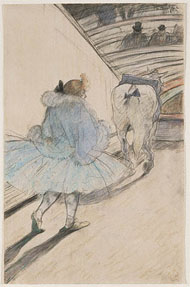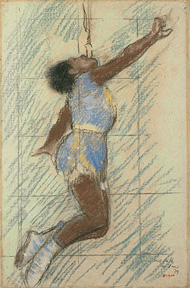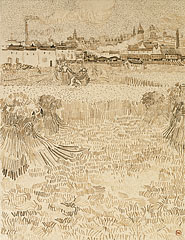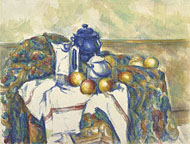|
During the 1800s artistic practice seemed to expand without limit, encompassing a wider variety of subjects, greater opportunities for the exhibition and sale of art, new publishing methods for reproductions and illustrations, and the manufacture of more convenient artist's materials.
Drawing was the foundation of artistic training from the Renaissance forward, and retained this fundamental role through the 1800s. The drawings in this exhibition exemplify the 19th-century negotiation between tradition and innovation, revealing how the practice of drawing benefited from and advanced the developments of artistic modernity. Like many artists working in the 1880s, Georges Seurat sought to portray the contemporary world using an artistic language that was both modern and classic. The figure above, rendered in profile with only the slightest details, achieves the iconic monumentality that Seurat admired in ancient art. Seurat's confidence in his use of the Conté crayon, a medium introduced in the early 1800s, can be seen in the varying densities of black that indicate the woman's hat, veil, and nose.
|
 |
|
During the early 1870s Camille Pissarro began experimenting with the emerging Impressionist painting style by using watercolor. Although artists used watercolor in previous centuries, the medium came into its own during the 1800s thanks in part to the manufacture of a great variety of specialty materials: dry pigments in cakes; wet pigments in tubes; soft-bristled brushes with tapered tips; and thick, textured papers.
Many of Pissarro's landscapes from this period show the roads into and out of Louveciennes, the town west of Paris where he lived. In this finished work, Pissarro first indicated the main features of the composition using black chalk, then fleshed out the composition by covering the entire paper with watercolor. His wet, fluid technique rendering the blustery skies captured the sense of fall turning to winter.
|
 |
|
Henri de Toulouse-Lautrec created a series of 50 drawings of circus subjects while hospitalized for alcoholism and dementia in the spring of 1899. Colored pencils, first manufactured during the early 1800s, were among the drawing materials his mother brought him. These early pencils had less pigment than those available today and were only offered in limited colors. They were just beginning to be marketed for artistic use when Toulouse-Lautrec created this drawing.
The circus had been one of Toulouse-Lautrec's signature subjects during the 1880s. He relied on his memory to create this remarkable backstage view of a performer and her horse shuffling into the ring. The composition highlights two hallmarks of Toulouse-Lautrec's artistic style: an acute description of physical types and brilliant use of color, particularly dazzling in the shadows at lower left.
|
 |
|
Miss Lala was an acrobat famous for her feats of strength, and Edgar Degas saw her perform on numerous occasions. Here, she is being hoisted to the circus rafters by a rope held in her teeth. Degas made several studies of the soaring Miss Lala, positioning her head, legs, and arms to evoke effort and upward movement. Using pastel, Degas suggested the iridescent fabric of Miss Lala's costume with layered passages of bright yellow and purple, and created her shock of hair by deliberately smudging the pastel.
• See the painting at the National Gallery, London that Degas made from this study. (Links to National Gallery, London, Web site.)
|
 |
|
In the summer of 1888, while living in Arles, Vincent van Gogh made a group of paintings and drawings exploring the theme of the harvest, and wrote to his brother Theo: "I work even in the middle of the day, in the full sunshine, without any shadow at all, in the wheat fields, and I enjoy it like a cicada."
This drawing showcases Van Gogh's expressive graphic vocabulary, relying on intersecting patterns of parallel lines and tiny dots to present an abrupt meeting between the cleared fields and the dense Arles cityscape.
|
 |
|
Henri Fantin-Latour first depicted an uninspired artist turning from his easel in an 1868 sketchbook. Almost 30 years later, he revisited the subject in this finished sheet. By portraying a painter in contemporary dress being comforted by three otherworldly beings, Fantin-Latour elevated the subject of the artist in the studio into a modern allegory. His application of lithographic crayon in rapid, diagonal strokes created an interplay of black and white that contributes to the drawing's mysterious atmosphere.
|
 |
|
During the 1870s Paul Cézanne turned to still-life painting and soon became famous for his works in that genre. During the last years of his life he made a number of highly finished still-life watercolors, experimenting both with composition and with the medium itself.
In this monumental sheet, Cézanne showcased his technique, reserving white paper for the milk jug, sugar bowl, and cloth at center while surrounding them with the blue pot, golden apples, and flowered tapestry, all created with painstakingly layered washes.
This exhibition is located at the Getty Center, West Pavilion.
|
 |






